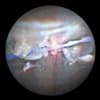Are These Your Happy Patients?
These ECP success stories show that incorporating this
technology has increased patient and surgeon satisfaction.

The best candidate for endoscopic cyclophotocoagulation (ECP) is the patient who has controlled glaucoma, is on two or more drops and needs cataract surgery. We have a great opportunity to ask this patient, "After your cataract surgery, you're not going to need eyeglasses. Would it be a benefit to you if you also didn't need glaucoma drops?"
I'm sure the answer is a definite "yes." This patient would benefit, not only by avoiding ocular side effects and toxicity, but also by eliminating the financial burden of having to buy all those drops. Even a reduction of one or two drops is a great service to patients.

On average, I've seen a 35% reduction in intraocular pressure and at the same time, a 35% reduction in glaucoma drops after a patient has had ECP. Put another way, a patient whose pressure is 20 mm Hg on three drops preoperatively could easily have an IOP of 14 mm Hg on two drops postoperatively.
The most dramatic effect I've seen thus far with ECP was with a man who had severe glaucoma -- 0.95 cups and a dense altitudinal field defect. This patient really needed to keep his pressures low. He had a well-functioning trabeculectomy and his pressure was controlled at about 12 mm Hg.
Then, the patient developed a very dense posterior subcapsular cataract that required surgery. Unfortunately, his trabeculectomy failed about a month after surgery, and his pressure shot up to a dangerous 52 mm Hg. This patient had been on no medications but suddenly, in the middle of the night, I had to put him on every available med to get his pressure down.
His pressure dropped into the teens, but I wasn't satisfied with his situation. I told him, "I just don't think taking all these medications is an acceptable long-term treatment. What we need to do is bring you back and do ECP."
The result was dramatic. Following ECP, his pressure dropped from 52 mm Hg to 12 mm Hg.
|
A New Mindset |
|
| Endoscopic cyclophotocoagulation (ECP) is a very different procedure from the cyclodestructive procedures to which we're accustomed. With those, you're "cooking" the entire ciliary body and the sclera, whether you're using a laser or freezing it. And that's going to incite a lot of inflammation. ECP is a controlled application of laser energy just to the ciliary epithelium, so it really does a nice job. | |
Not all ECP results are as dramatic, but this procedure can produce an immediate benefit for patients. For example, I had a patient with normal-tension glaucoma whose pressure was 11 mm Hg but with the support of five medications (four drops). By using ECP, I was able to eliminate the need for medication. This patient's pressure is now 12 mm Hg instead of 11 mm Hg, but he no longer needs to use five medications, and he's quite happy about that.
Virtually Worry-free
Endoscopic cyclophotocoagulation is a wonderful procedure to be able to do for people. The best part about it for surgeons is that we don't have the intense worry about complications and side effects that we do with a trabeculectomy. With ECP, we don't have to be concerned about hypotony, choroidal detachment or wound leaks. They're just not going to happen.
Follow-up for ECP patients is similar to that for cataract patients. In terms of anti-inflammatory use after ECP, I use the same regimen as I do for standard cataract surgery. I prescribe Pred Forte four times a day for 1 week and then twice a day for 2 weeks. I also prescribe an NSAID and an antibiotic four times a day for the first week. I usually see patients 1 day and 2 weeks post-op and then on a normal glaucoma follow-up schedule, which might be in a month or two, depending on the disease severity. And then I titrate their drops.
Happy Surgeons Happy Patients
The benefits of ECP for patients are enormous. Just think about how many of your cataract patients also are taking glaucoma medications. Every one of them is a candidate for ECP, and once they've had the procedure, they'll thank you for it. There's no happier glaucoma patient than the one who's told, "You don't need these drops anymore."
Dr. Packer is clinical assistant professor at the Casey Eye Institute, Department of Ophthalmology, Oregon Health and Science University. He practices in Eugene, Ore., with I. Howard Fine, M.D., and Richard S. Hoffman, M.D.
|
ECP Do's and Don'ts |

After 2-1/2 years' experience with this technology, I've come to recognize I'll achieve the best outcomes by taking my time and carefully ablating each process. Here's a quick checklist to keep in mind:
|
|
For Greater Effect |
| If you want an even greater effect with ECP, you can do scleral depression with a Q-tip to separate the processes and treat between them. Even doing so will not risk completely shutting down aqueous production. |
|
Other Uses for the Endoscope |
||||
The endoscope is very useful for other applications outside of cyclo-photocoagulation. In doing IOL exchange, for example, I can use the scope to determine:
|









